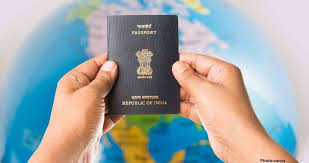
Beyond Paper: India’s Journey to Advanced Biometric E-Passports
Beyond Paper: India’s Journey to Advanced Biometric E-Passports
India has now joined over 120 countries in issuing biometric e-passports, marking an important step in modernizing its travel and identity security systems. Unlike traditional passports, India’s e-passport contains a microprocessor chip using Radio Frequency Identification (RFID) technology, which securely stores personal details such as name, date of birth, passport number, along with biometric data like facial images and fingerprints. A digital signature authenticates this data, which is encrypted to ensure privacy and prevent tampering. Interestingly, while the residential address is not printed on the passport, it is stored securely on the chip and can only be accessed by authorized personnel at airports. This move aligns with the Digital India initiative and follows global standards set by the International Civil Aviation Organization (ICAO), enabling faster immigration clearance through automated e-gates and enhancing traveler privacy worldwide.
What Makes the e-Passport Modern and Secure?
The e-passport, also called a biometric passport, represents a major upgrade from regular passports. It integrates a tiny electronic chip inside the passport cover that stores and wirelessly transmits essential identity and biometric information. This makes identity verification at border crossings faster and more reliable while reducing risks like forgery and identity theft.
These passports are developed following ICAO’s technical guidelines, ensuring that countries worldwide use interoperable, trustworthy systems for identifying travelers.
How Does Technology Work?
At the heart of the e-passport is a small chip embedded in the back cover. This chip communicates wirelessly with authorized reading devices via RFID. It stores encrypted personal and biometric data protected by strong cryptography. This technology not only speeds up travel but also includes built-in features to detect if anyone tries to tamper with or hack the passport.
What Data is Stored?
The chip holds both biographic data visible on the passport’s information page — like name, nationality, and date of birth — and biometric identifiers such as digitized facial images and fingerprints. Some countries also include iris scans. ICAO’s Logical Data Structure standard organizes this data in layers:
- The main data layer (LDS1) holds the primary personal and biometric details locked once the passport is issued.
- An optional second layer (LDS2) can store additional information like electronic visas or travel history, making the passport more versatile while maintaining security.
Every piece of data is digitally signed and encrypted, so any attempt to alter it is immediately detectable during verification.
Keeping Data Safe: Access Control Mechanisms
To prevent unauthorized reading or skimming of the chip, e-passports use several security protocols:
- Basic Access Control (BAC): Uses a session key derived from the passport’s Machine Readable Zone (MRZ) data to restrict access. However, this method can be vulnerable to certain attacks due to the limited complexity of MRZ information.
- Password Authenticated Connection Establishment (PACE): A stronger protocol using asymmetric encryption that protects against eavesdropping and man-in-the-middle attacks. This is now a global standard for e-passports.
- Supplemental Access Control (SAC): Combines BAC and PACE for compatibility with older systems while ensuring better security. SAC has been mandatory since 2018.
Together, these layers protect against hidden skimming attempts in crowded places where multiple RFID readers might be present.
Authenticating the Passport: Proving It’s Genuine
To make sure the passport chip hasn’t been cloned or forged, e-passports rely on several cryptographic methods:
- Passive Authentication (PA): Verifies the chip’s digital signature to confirm data integrity.
- Active Authentication (AA): Uses public-key cryptography to confirm the chip is authentic and not a clone, by signing a challenge message from the reader.
- Additional steps like Chip Authentication and Terminal Authentication further secure communication and ensure only trusted readers can access sensitive data, especially when updating biometric information or visas after issuance.
Public Key Infrastructure (PKI): The Trust Network
A key part of the system is the Public Key Infrastructure, where Certificate Authorities issue digital certificates to both passports and authorized readers, creating a trusted network. India’s Supervisory Public Key Infrastructure Offline Center (SPOC) manages root certificates securely offline, minimizing risks. Globally, ICAO’s Public Key Directory (PKD) helps countries share their certificates and revocation lists efficiently, simplifying international verification.
Why e-Passports Matter: Benefits at a Glance
- Better security: Encrypted biometric data and digital signatures drastically reduce forgery and impersonation risks.
- Faster border crossings: Automated e-gates speed up processing and reduce queues.
- Greater reliability: Cross-checking digital and printed data with biometrics helps spot fraudulent passports quickly.
Countries like the US, Germany, Japan, and India are already using e-passports to enhance border security and combat identity-related crimes.
Challenges and Privacy Concerns
Despite their benefits, e-passports raise some privacy issues. Unauthorized scanners could potentially read data if the chip isn’t adequately protected. Also, the RFID chip emits a unique identifier that, if not randomized, could allow tracking of the passport holder’s movements over time. Though facial images are semi-public, combining them with other personal data could enable identity theft or profiling.
The Road Ahead: Strengthening Security and Privacy
To build and maintain trust in e-passports, countries need to take some important steps. Strong encryption methods like PACE and SAC are key to keeping the personal data on the chips safe. Using protective covers or sleeves that block unauthorized RFID scans helps stop any unwanted access to passport information. Adding randomized unique identifiers can prevent passports from being used to track people. It’s also vital to keep digital certificates updated and regularly test systems to ensure they work well with others worldwide. On top of that, raising awareness among the public about how to handle e-passports securely plays a big role in protecting privacy and security.
India’s steady rollout of e-passports across various cities shows a clear dedication to creating a modern, secure, and globally respected identity system. As technology keeps moving forward, staying alert, cooperating internationally, and focusing on privacy-driven innovation will be essential to make sure e-passports remain safe and reliable for all travelers.